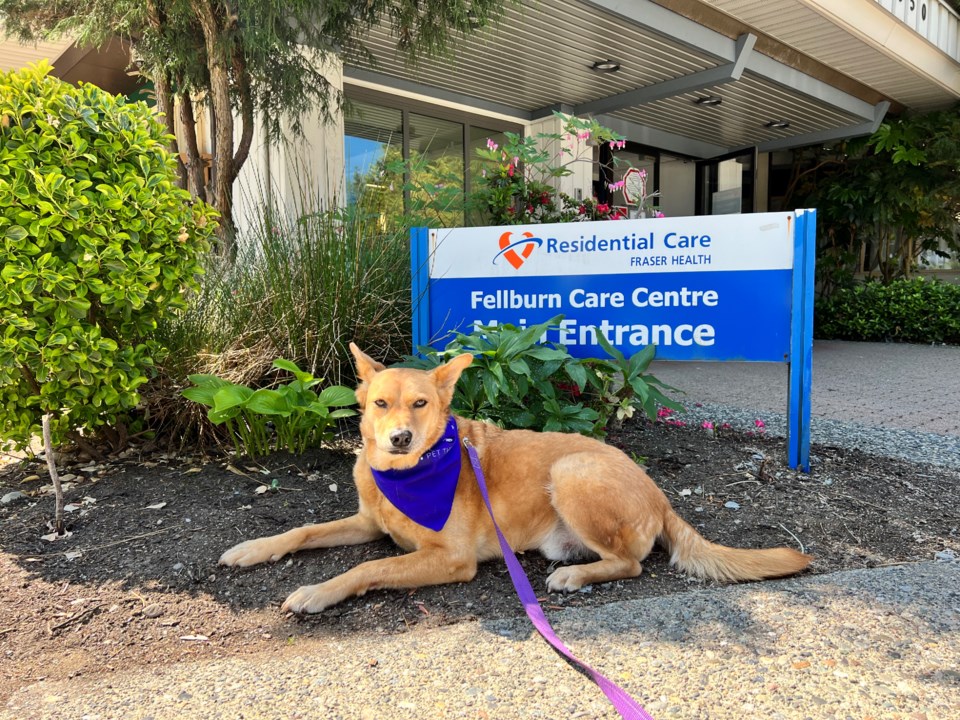It’s a regular ol’ day for Milo.
He wakes up, puts on his uniform — a purple-coloured bandana — and excitedly goes to work.
Sometimes to Fellburn Care Centre over on Hastings Street, sometimes to Burnaby Hospital.
Milo is a visiting “therapist” at the hospitals — listening to people, helping them to smile wholeheartedly — and the cutest of them all, with four legs and a wagging tail.
He is a volunteer therapy dog with Pets and Friends, a non-profit organization that aims to spread "paws-itivity" to communities.
Jasmine McCulligh (his dog-mom) said Milo loves his job and is always excited to go to work. Although he's a lazy dog at home, she said he’s all excited the moment his Pets and Friends bandana is on.
“As soon as we’re out of the car and at the facility, he (Milo) will literally drag me to the doors,” she said. “And he knows where he is going.”
“Getting out of the elevator at the hospital, he knows exactly what his job is and he has his favourite sections to go to at the hospital. He knows who needs the love and who he should engage with the most.”
Milo and McCulligh have been volunteering with Pets and Friends since October 2015.
But McCulligh said she knew right away when she adopted Milo that he was destined to be a therapy dog.
“If we went out in public, everyone he interacted with always said he's friendly, he loves everybody, he's my best friend, that type of thing … so when I found an advertisement for Pets and Friends, I thought he would be a really good fit for it.”
The screening process for Milo volunteering as a pet therapist involved his response to different environments, noises and out-of-the-ordinary happenings one might encounter in a long-term care facility or a hospital — to make sure would be able to handle it well and handle being pet by multiple people.
Milo loves everybody equally — he doesn’t care if you’re in a wheelchair, wearing a blue sweater or a green sweater, McCulligh said.
Therapy dog brings joy, relieves stress for patients
That love is deeply felt by the people he visits.
For many seniors living in long-term care, the sight of Milo is very welcoming; their eyes light up when he walks in.
“You could see the smiles on their faces,” said Pina Scaglione, a partnership and development manager at Pets and Friends.
“They would be so happy and so excited, (you could see) complete joy on their faces when they would see Milo.”
For many, she said, the sight of a therapy dog is reminiscent of the happier times in their lives spent with their own dogs.
“A lot of the times, (residents) may have had dogs in their past or they may have had dogs that are left at home with their families, that they weren't able to see during the pandemic or their dogs have passed away,” she said.
“So it’s great for the residents to have reminders of what their lives with their own dogs were like and the joy, comfort and love they felt from them.”
Moreover, therapy animals help bring a relief to social isolation for these residents, she said.
McCulligh, who works in science, said the impact of therapy dogs can be evidently seen.
“It's interesting to see that it's not just that they're smiling,” she said. “Their stress levels are literally going down… you can see that. (There was) a patient who was very quiet. And as soon as he started petting Milo, he started talking, asking all these questions, getting down on the floor and playing with Milo; you can immediately see that change in somebody's demeanour.”
McCulligh said that she herself knew the magical connection with a dog when she wasn’t able to have one. So being able to share that with somebody who can't have a dog is really important for her — and a reason she and Milo volunteer.
Milo gets rewarded too — with love and treats.
If you have a dog and would like to volunteer as a pet therapy team, visit the organization for more information on volunteering and donations here.



